
The Fiat Croma name was used for two distinct large family cars by Fiat, one a five door liftback manufactured and marketed from 1985 to 1996, and after a nine-year hiatus, a crossover station wagon manufactured and marketed from 2005 to 2010.

The Fiat Tipo is a compact car, designed by the I.DE.A Institute design house, and produced by the Italian manufacturer Fiat between 1988 and 1995.

The Fiat Tempra is a small family car produced by the Italian automaker Fiat from 1990 to 1996 in Italy. The Tempra was intended as a replacement for the Fiat Regata. The original project was called Tipo 3, being a mid-size car between the Fiat Tipo and the bigger Fiat Croma. The Tempra shares its Type Three platform with the Lancia Dedra and Alfa Romeo 155.
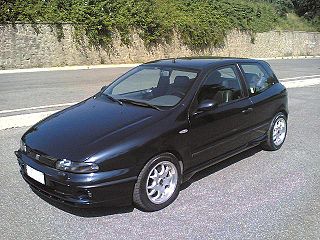
The Fiat Bravo and Fiat Brava are small family cars produced by the Italian automaker Fiat from 1995 to 2003. They were effectively two versions of the same car: the Bravo, a three-door hatchback, and the Brava, a five-door fastback. The Bravo name was revived in January 2007, with the all-new Fiat Bravo, a replacement for the Stilo. The new version was available only with five doors.

The Fiat Stilo is a small family car available as a three- and a five-door hatchback, as well as an estate, produced by Italian automaker Fiat. The Stilo hatchbacks were presented in March 2001, at the Bologna Motor Show and launched in October 2001 to replace the Fiat Bravo/Brava, with the Stilo Multi Wagon following in January 2003.

The Fiat Ritmo is a small, front-engine, front-wheel drive family car manufactured and marketed by Fiat, launched in April 1978 at the Turin Motor show and offered in 3- and 5-door hatchback and cabriolet body styles – from 1978 to 1988 with two facelifts.

The Fiat 131 is a family sedan manufactured and marketed by Fiat from 1974 to 1984 after its debut at the 1974 Turin Motor Show. Available as a two-door and four-door saloon and 5-door estate across a single generation, the 131 succeeded the Fiat 124.

The Fiat Doblò is a panel van and leisure activity vehicle produced by Italian automaker Fiat since 2000. It was unveiled at the Paris Motor Show in October 2000. A second-generation Doblò succeeded the original vehicle in 2010 for most markets, and it was sold in the United States as the RAM ProMaster City from 2015 to 2022. The third-generation Doblò, a rebadged version of the Citroën Berlingo, was unveiled in June 2022.
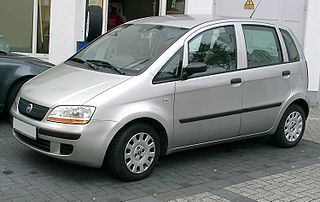
The Fiat Idea is a car manufactured and marketed by Fiat from 2003 to 2012 over a single generation with one intermediate facelift. It is a five-passenger mini MPV with five doors. It has a front-engine, front-wheel drive layout.
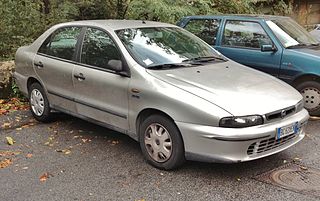
The Fiat Marea is a small family car available as a saloon and an estate, produced by the Italian automaker Fiat. Launched in September 1996, the Marea models were essentially different body styles of Fiat's hatchback offerings, the Bravo and Brava. The Marea replaced the earlier Tipo based Fiat Tempra, as well as the larger Croma.

The Fiat Regata is an automobile produced by Italian automaker Fiat from 1983 until 1990. The Regata name was used for the sedan and station wagon versions of the Fiat Ritmo hatchback, corresponding to the post-facelift Ritmo. The Regata was offered with a choice of three petrol and two diesel engines, although Fiat's Argentinean operations installed other engines from later Fiat models as production there continued until 1995.

The Fiat Fiorino is a small commercial vehicle produced by the Italian car manufacturer Fiat since 1977. Its first two generations have been the panel van derivatives of other small models, such as the Fiat 127 and Fiat Uno, while the current third generation was developed jointly with PSA Peugeot Citroën, and is based on the Fiat Small platform.

Tofaş is a Turkish automobile manufacturer which was established in 1968 by Vehbi Koç, who was the founder of Koç Holding, based in Bursa, where the manufacturing plant of the company is located. It is jointly owned by Stellantis and Koç Holding.

The Eurovans are a family of passenger automobiles from the Citroën, Peugeot, Fiat and Lancia marques that were produced at the jointly owned Sevel Nord factory in France. The term Eurovan was not used by the brands themselves in sales literature, but rather by the motoring press to refer to the vans collectively. It was launched in March 1994, and production ceased in November 2010 for the Fiat and Lancia models, and in June 2014 for the Citroën and Peugeot siblings. They are considered to be large MPVs.
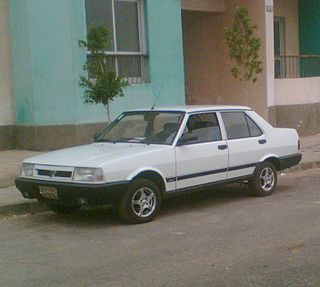
The Tofaş Murat 131, Şahin, Doğan, and Kartal are Turkish versions of the Fiat 131 automobile made in the Türk Otomobil Fabrikası A.Ş. factory in Bursa, Turkey. While doğan means "falcon" in Turkish, kartal means "eagle" and şahin means "hawk". The car was built from 1977 and sold in Turkey until 2002, with Egyptian assembly coming to an end in 2009 and in Ethiopia until 2010.
1989 in motoring includes developments in the automotive industry throughout the year 1989 by various automobile manufacturers, grouped by country. The automotive industry designs, develops, manufactures, markets, and sells motor vehicles.
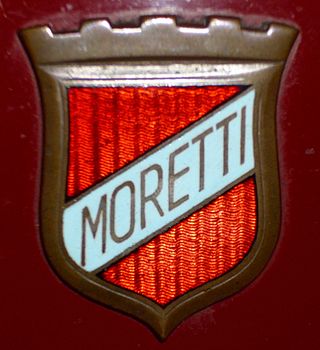
Moretti S.p.A. is a former Italian automobile manufacturer. It was founded in 1925 and ceased automobile production in December 1989. Today, many of its sports car models can still be found at various European auto shows. Moretti Motors produced a variety of models at various times including motorcycles, microcars, and several commercial vehicles.
The Fiat C-platform was an automobile platform used in small family cars of the Fiat Group. The predecessors of the C-platform were the Type Three and Type Two platforms, and the successor is the new Compact platform which debuted in Alfa Romeo Giulietta in 2010.
The Cassino Assembly Plant is a car assembly plant owned by Stellantis. It is located in the town of Piedimonte San Germano, three kilometres from Cassino, in the province of Frosinone, Italy. The car assembly plant started in 1972 with the production of Fiat 126. Today, it has a total surface area of 2 million square meters, of which 400 thousand are covered. The plant currently employs around 4,300 people.




















